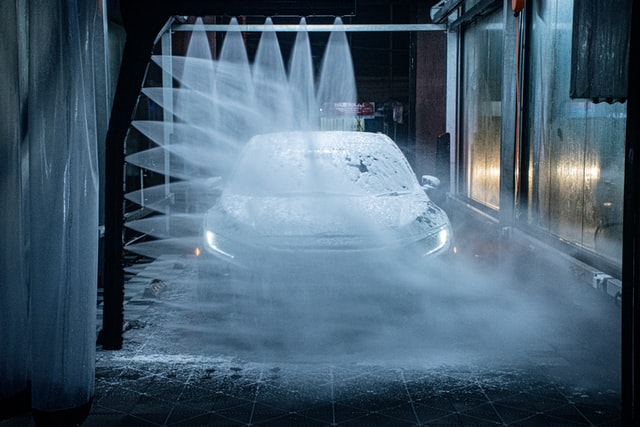My wife asked me to take our car to the car wash to clean out the sand and salt from a recent beach trip. I hopped in the car since I needed a break from my eleventh Zoom call of the day. I haven’t taken our car to a car wash since pre-Covid, March 2019.
I drove to the local Jiffy, Spiffy Zippy Whatever Express I used to go to in my past life. When I pulled in, they had completely changed how they were organized. It appeared to be an entirely new car wash.
I entered the line to pay and told the young attendant that I’d like to have the car washed and vacuumed inside.
I was met with a surprise.
“What, she said?”
You know, inside and outside. A car wash. Where you wash the car with soap and water, and then you vacuum and wipe clean the inside?
I jokingly asked, has life changed that much since the pandemic?
“Oh, we don’t do the vacuuming or clean your car inside anymore. You do it yourself. It’s called self-service or customer service.
This Sucks
As you may recall from other blogs, vacuuming isn’t something that sucks for me. I like to vacuum.
But I was expecting a full-service car wash where they do the work, and I get to stick my head in my phone scrolling through Twitter.
I was tired and thought this might take 15 minutes. Today, full service means the car wash guys do some of the work, and I must do the rest, and there is nothing Jiffy or Spiffy or Zippy about the customer experience.
When I spoke to the manager, she said, “we can’t get help, so we have a different way we do business. We installed these super turbo vacuuming systems, and the customer can use them to clean the insides and trunk of their car. The attendant will bring you towels and some spray, and you can clean it yourself.”
From Rags to Riches: A Labor Shortage
It seems that car washes, like many other businesses, can’t find people willing to work for a minimum wage of $7.25 an hour. Shocking.
And if they try to pay more, they compete with the new Amazon warehouse or thousands of other businesses that need workers. So instead of finding people who are paid a living wage, they opted for the latest marketing business model.
You do the work we used to do.
So, I did my vacuuming, and it took me about 45 minutes to meet my wife’s standard of cleanliness. Don’t ask. She’s particular.
I can only imagine the unexpected consequences for so many businesses that no longer have people doing work and instead burden the customer.
Customer Service Has a New Meaning. The Customer Does The Service.
Shifting the burden to the customer isn’t new.
Self-service check at the grocery store has existed for years, but more and more supermarkets are reducing the number of humans cashiers at checkout lanes and replacing them with the self-scanning system. My labor-friendly Whole Foods Markets, now owned by Amazon, has cut the cashier lanes in half, just in the last six months. BYOB. Bring your own bags and muscles.
Pretty soon, I’ll have to cut my hair, repair my shoes and fix my teeth.
Last night I saw a rerun of an old Seinfeld episode where Kramer wanted to start a pizza business where the customer makes their pizza. Jerry, George, and Elaine thought he was crazy, but it turns out he must have been prescient.
Factories across the U.S. are struggling to find employees to work on the frontline. In some recent conversations I had for a project, the companies I interviewed all told me the same story. They have so many unfilled positions they can’t fill. They must shut down lines or cut back on shifts.
And you wonder why some of the shelves are empty?
Businesses from retail to manufacturing that rely on people are in for some tough times. This work is physically demanding and filled with challenges. Companies are starting to look at alternative models to pivot to reduce their dependence on physical labor to serve their customers.
- American Airlines has trimmed its flight schedule. On a recent business trip to Miami, I had one flight option for the return. Before Covid, there were five options.
- Wages are going up as fast-food restaurants are offering $15 an hour. And still, they can’t fill these jobs as people are looking for better opportunities. Some restaurants are converting to low labor ghost kitchens where they prepare and deliver only – no in-dining seating.
- Amazon, Walmart and Target now offer free tuition and books for all employees working about 25 hours per week. It is both a story to sing about and, a great way to retain employees and lock them in from leaving.
- Truck drivers are a scarce resource and have been in great demand for years, and trucking firms have a 90% turnover rate for those positions. (where are the autonomous self-driving trucks?)
- There are 10 million job openings in the U.S., and last month labor report showed under 200,000 new jobs added to the economy in September.
One way of looking at this labor challenge and related supply chain problems is that it is like a game of musical chairs.
Patterns changed during Covid, and some lower-income individuals were getting supplemental income from the government. Many of these workers have been slow to reenter the workforce and are questioning and searching for better options.
And workers are quitting jobs at a high rate.
I keep hearing about the great resignation, but I think this is all temporary. Yes, there are many moving parts/people – and at some point, economists predict it will settle down. This fall, many thought it would return to normal, but Covid and Delta had a different idea.
At least once a year, businesses need to relook at the organizations, their business model and think about ways to reduce costs or add extra value to give them upward pricing power.
Job descriptions keep changing – we need more Amazon warehouse workers than retail store clerks. Jobs that were W2 are converting to 1099.
And the seasons go round and round.
As for me, I’m going to find a full-service car wash, stick to at-home vacuuming and find myself a chair.
You can set up a time to chat with me about your marketing challenges using my calendar. Email me jeffslater@themarketingsage.com Call me. 919 720 0995. The conversation is free, and we can explore if working together makes sense. Watch a short video about working with me.
Photo by Zulfahmi Khani on Unsplash






